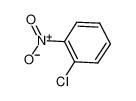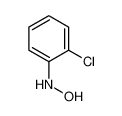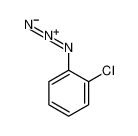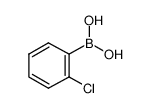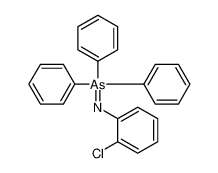1.Identification
1.1 GHS Product identifier
| Product name | 2-Chloroaniline |
|---|
1.2 Other means of identification
| Product number | - |
|---|---|
| Other names | Benzenamine, 2-chloro- |
1.3 Recommended use of the chemical and restrictions on use
| Identified uses | For industry use only. |
|---|---|
| Uses advised against | no data available |
1.4 Supplier's details
| Company | MOLBASE (Shanghai) Biotechnology Co., Ltd. |
|---|---|
| Address | Floor 4 & 5, Building 12, No. 1001 North Qinzhou Road, Xuhui District, Shanghai, China |
| Telephone | +86(21)64956998 |
| Fax | +86(21)54365166 |
1.5 Emergency phone number
| Emergency phone number | +86-400-6021-666 |
|---|---|
| Service hours | Monday to Friday, 9am-5pm (Standard time zone: UTC/GMT +8 hours). |
2.Hazard identification
2.1 Classification of the substance or mixture
Acute toxicity - Oral, Category 3
Acute toxicity - Dermal, Category 3
Eye irritation, Category 2
Acute toxicity - Inhalation, Category 3
Germ cell mutagenicity, Category 2
Specific target organ toxicity – repeated exposure, Category 2
Hazardous to the aquatic environment, long-term (Chronic) - Category Chronic 1
2.2 GHS label elements, including precautionary statements
| Pictogram(s) |    |
|---|---|
| Signal word | Danger |
| Hazard statement(s) | H301+H311+H331 Toxic if swallowed, in contact with skin or if inhaled H318 Causes serious eye damage H341 Suspected of causing genetic defects H373 May cause damage to organs through prolonged or repeated exposure H410 Very toxic to aquatic life with long lasting effects |
| Precautionary statement(s) | |
| Prevention | P264 Wash ... thoroughly after handling. P270 Do not eat, drink or smoke when using this product. P280 Wear protective gloves/protective clothing/eye protection/face protection. P261 Avoid breathing dust/fume/gas/mist/vapours/spray. P271 Use only outdoors or in a well-ventilated area. P201 Obtain special instructions before use. P202 Do not handle until all safety precautions have been read and understood. P260 Do not breathe dust/fume/gas/mist/vapours/spray. P273 Avoid release to the environment. |
| Response | P301+P310 IF SWALLOWED: Immediately call a POISON CENTER/doctor/… P321 Specific treatment (see ... on this label). P330 Rinse mouth. P302+P352 IF ON SKIN: Wash with plenty of water/... P312 Call a POISON CENTER/doctor/…if you feel unwell. P361+P364 Take off immediately all contaminated clothing and wash it before reuse. P305+P351+P338 IF IN EYES: Rinse cautiously with water for several minutes. Remove contact lenses, if present and easy to do. Continue rinsing. P337+P313 If eye irritation persists: Get medical advice/attention. P304+P340 IF INHALED: Remove person to fresh air and keep comfortable for breathing. P311 Call a POISON CENTER/doctor/… P308+P313 IF exposed or concerned: Get medical advice/ attention. P314 Get medical advice/attention if you feel unwell. P391 Collect spillage. |
| Storage | P405 Store locked up. P403+P233 Store in a well-ventilated place. Keep container tightly closed. |
| Disposal | P501 Dispose of contents/container to ... |
2.3 Other hazards which do not result in classification
none
3.Composition/information on ingredients
3.1 Substances
| Chemical name | Common names and synonyms | CAS number | EC number | Concentration |
|---|---|---|---|---|
| 2-Chloroaniline | 2-Chloroaniline | 95-51-2 | none | 100% |
4.First-aid measures
4.1 Description of necessary first-aid measures
General advice
Consult a physician. Show this safety data sheet to the doctor in attendance.
If inhaled
Fresh air, rest. Artificial respiration may be needed. Refer for medical attention.
In case of skin contact
Remove contaminated clothes. Rinse and then wash skin with water and soap. Refer for medical attention .
In case of eye contact
First rinse with plenty of water for several minutes (remove contact lenses if easily possible), then refer for medical attention.
If swallowed
Rinse mouth. Give one or two glasses of water to drink. Refer for medical attention .
4.2 Most important symptoms/effects, acute and delayed
SYMPTOMS: Symptoms of exposure to this compound may include headache, nausea, vomiting, jaundice, convulsions, severe kidney damage, liver damage, methemoglobin formation and in sufficient concentrations, cyanosis; skin and eye irritation; and dermatitis. Onset may be delayed 2-4 hours or longer. ACUTE/CHRONIC HAZARDS: This compound is toxic by ingestion, inhalation and contact with the skin. It may cause irritation of the skin.
4.3 Indication of immediate medical attention and special treatment needed, if necessary
Methylene blue, alone or in combination with oxygen, is indicated as treatment in nitrite-induced methemoglobinemia.
5.Fire-fighting measures
5.1 Extinguishing media
Suitable extinguishing media
Water, dry chemical, foam or carbon dioxide /4-chloroaniline/
5.2 Specific hazards arising from the chemical
This chemical is combustible.
5.3 Special protective actions for fire-fighters
Wear self-contained breathing apparatus for firefighting if necessary.
6.Accidental release measures
6.1 Personal precautions, protective equipment and emergency procedures
Use personal protective equipment. Avoid dust formation. Avoid breathing vapours, mist or gas. Ensure adequate ventilation. Evacuate personnel to safe areas. Avoid breathing dust. For personal protection see section 8.
6.2 Environmental precautions
Personal protection: chemical protection suit including self-contained breathing apparatus. Do NOT let this chemical enter the environment. Collect leaking and spilled liquid in sealable containers as far as possible. Absorb remaining liquid in sand or inert absorbent. Then store and dispose of according to local regulations.
6.3 Methods and materials for containment and cleaning up
Pick up and arrange disposal. Sweep up and shovel. Keep in suitable, closed containers for disposal.
7.Handling and storage
7.1 Precautions for safe handling
Avoid contact with skin and eyes. Avoid formation of dust and aerosols. Avoid exposure - obtain special instructions before use.Provide appropriate exhaust ventilation at places where dust is formed. For precautions see section 2.2.
7.2 Conditions for safe storage, including any incompatibilities
Separated from food and feedstuffs. Keep in the dark. Well closed.
8.Exposure controls/personal protection
8.1 Control parameters
Occupational Exposure limit values
no data available
Biological limit values
no data available
8.2 Appropriate engineering controls
Handle in accordance with good industrial hygiene and safety practice. Wash hands before breaks and at the end of workday.
8.3 Individual protection measures, such as personal protective equipment (PPE)
Eye/face protection
Safety glasses with side-shields conforming to EN166. Use equipment for eye protection tested and approved under appropriate government standards such as NIOSH (US) or EN 166(EU).
Skin protection
Wear impervious clothing. The type of protective equipment must be selected according to the concentration and amount of the dangerous substance at the specific workplace. Handle with gloves. Gloves must be inspected prior to use. Use proper glove removal technique(without touching glove's outer surface) to avoid skin contact with this product. Dispose of contaminated gloves after use in accordance with applicable laws and good laboratory practices. Wash and dry hands. The selected protective gloves have to satisfy the specifications of EU Directive 89/686/EEC and the standard EN 374 derived from it.
Respiratory protection
Wear dust mask when handling large quantities.
Thermal hazards
no data available
9.Physical and chemical properties
| Physical state | Clear amber liquid |
|---|---|
| Colour | Amber liquid |
| Odour | Characteristic sweet odor |
| Melting point/ freezing point | -2°C(lit.) |
| Boiling point or initial boiling point and boiling range | 209°C(lit.) |
| Flammability | Combustible. Gives off irritating or toxic fumes (or gases) in a fire. |
| Lower and upper explosion limit / flammability limit | no data available |
| Flash point | 104°C(lit.) |
| Auto-ignition temperature | >/=500°C |
| Decomposition temperature | no data available |
| pH | no data available |
| Kinematic viscosity | 2.9157 cP at 20°C |
| Solubility | In water:5.13 g/L (20 ºC) |
| Partition coefficient n-octanol/water (log value) | log Kow = 1.90 |
| Vapour pressure | 1 mm Hg at 46.28°C ; 5 mm Hg at 72.28°C; 760 mm Hg at 208.78°C |
| Density and/or relative density | 1.213 |
| Relative vapour density | 4.4 (Relative to Air) |
| Particle characteristics | no data available |
10.Stability and reactivity
10.1 Reactivity
no data available
10.2 Chemical stability
Darkens on exposure to air.
10.3 Possibility of hazardous reactions
O-CHLOROANILINE is incompatible with acids, acid chlorides, acid anhydrides, chloroformates and strong oxidizing agents.
10.4 Conditions to avoid
no data available
10.5 Incompatible materials
Darkens with exposure to air. (TOXNET HSDB)
10.6 Hazardous decomposition products
When heated to decomposition, it emits toxic fumes of /hydrogen chloride and nitrogen oxides/.
11.Toxicological information
Acute toxicity
- Oral: LD50 Mouse oral 256 mg/kg
- Inhalation: LC50 Rat inhalation 4000-6000 mg/cu m/4 hr
- Dermal: no data available
Skin corrosion/irritation
no data available
Serious eye damage/irritation
no data available
Respiratory or skin sensitization
no data available
Germ cell mutagenicity
no data available
Carcinogenicity
no data available
Reproductive toxicity
no data available
STOT-single exposure
no data available
STOT-repeated exposure
no data available
Aspiration hazard
no data available
12.Ecological information
12.1 Toxicity
- Toxicity to fish: LC50 Pimephales promelas (Fathead minnow) 5.65 mg/L/96 hr; flow-through
- Toxicity to daphnia and other aquatic invertebrates: EC50 Daphnia magna (Daphnids; ability to swim) 4.2 mg/L/24 hr /Conditions of bioassay not specified in source examined
- Toxicity to algae: EC50 Scenedesmus subspicatus (Green algae; inhibition of cell multiplication) 90 mg/L/48 hr; 40 mg/L/72 hr; 35 mg/L/96 hr; static
- Toxicity to microorganisms: no data available
12.2 Persistence and degradability
AEROBIC: The results of biodegradability screening studies for 2-chloroaniline are conflicting with results ranging from no degradation to rapid degradation using soil, sewage, activated sludge and fresh water inocula(SRC). 2-Chloroaniline was found to be resistant to microbial degradation using the standard biodegradability test of the Japanese Ministry International Trade and Industry (MITI), a BOD test utilizing a mixed inoculum of activated sludge, sewage, and surface water(1,2). Only 2.7% of the 2-chloroaniline (100 ppm) degraded in a 2-week period in the MITI test(2). A 36% BODT was measured over a 190 hour incubation period with a Warburg respirometer(3). Half-lives greatly in excess of 4 weeks in both adapted and non-adapted inoculum were observed using the Repetitive Die Away (semistatic system) and Pitter (dynamic system) tests(4). No biodegradation was observed using modified procedures of the OECD and MITI test methods(5,6). Results of standard biodegradation tests were reported as follows: Coupled units, 5-6% DOC removal; Zahn-Wellens, 94% DOC removal; MITI, 0% BODT; Sturm, 0% CO2 evolution, 9% DOC removal; Closed bottle, 0% BODT(7). Another investigator obtained 85% DOC removal in 11 days in the Zahn-Wellens test(8). 2-Chloroaniline (2 mg/L) was found to be not readily biodegradable with a 10% BOD observed after 5 days in a mixed inoculum of river water collected from the Songhua River in China(9). Incubation of 2-chloroaniline in soil for 14 days resulted in formation of dichloroazobenzene, but no dichloroazobenzene was formed using sterilized soil(10). 100% loss of UV absorbance by microbial degradation in a mineral salts solution, with a soil inoculum, required an excess of 64 days(11). When 2-chloroaniline (3 ppm) was incubated in Guelph loam with water added to 60% water-holding capacity, levels declined rapidly for 2 weeks after which time the rate of loss decreased(12). The percent of 2-chloroaniline remaining in soil after 2 and 8 weeks were 40 and 20%, respectively(12).
12.3 Bioaccumulative potential
The average BCFs in the whole body of carp exposed to 2-chloroaniline in flow-through experiments (25°C, 12L/hr) for 24 to 336 hours at high (16.1 ug/L) and low (0.83 ug/L) exposure levels were 2.0 and 3.7, respectively(1). Uptake was rapid in static tests (0.19 umol/L, 26°C) on zebrafish and a BCF of 15.3 was obtained for 24 hour exposure(2). Log BCF of 2-chloroaniline in fish were experimentally determined to be less than 2.0 using the Japanese MITI test procedures(3). In an 8-week test performed at two concentration levels, the BCF of 2-chloroaniline in carp was 5.4-9.0 (0.1 ppm) and <14-32 (0.01 ppm)(4). According to a classification scheme(5), these BCF values suggest that bioconcentration in aquatic organisms is low(SRC), provided the compound is not altered physically or chemically once released into the environment.
12.4 Mobility in soil
The Koc of 2-chloroaniline is estimated as 260(SRC), using a log Kow of 1.9(1) and a regression-derived equation(2). According to a classification scheme(3), this estimated Koc value suggests that 2-chloroaniline is expected to have moderate mobility in soil. However, aromatic amines are expected to bind strongly to humus or organic matter in soils due to the high reactivity of the aromatic amino group(4,5), suggesting that mobility may be much lower in some soils(SRC).
12.5 Other adverse effects
no data available
13.Disposal considerations
13.1 Disposal methods
Product
The material can be disposed of by removal to a licensed chemical destruction plant or by controlled incineration with flue gas scrubbing. Do not contaminate water, foodstuffs, feed or seed by storage or disposal. Do not discharge to sewer systems.
Contaminated packaging
Containers can be triply rinsed (or equivalent) and offered for recycling or reconditioning. Alternatively, the packaging can be punctured to make it unusable for other purposes and then be disposed of in a sanitary landfill. Controlled incineration with flue gas scrubbing is possible for combustible packaging materials.
14.Transport information
14.1 UN Number
| ADR/RID: UN2019 | IMDG: UN2019 | IATA: UN2019 |
14.2 UN Proper Shipping Name
| ADR/RID: CHLOROANILINES, LIQUID |
| IMDG: CHLOROANILINES, LIQUID |
| IATA: CHLOROANILINES, LIQUID |
14.3 Transport hazard class(es)
| ADR/RID: 6.1 | IMDG: 6.1 | IATA: 6.1 |
14.4 Packing group, if applicable
| ADR/RID: II | IMDG: II | IATA: II |
14.5 Environmental hazards
| ADR/RID: yes | IMDG: yes | IATA: yes |
14.6 Special precautions for user
no data available
14.7 Transport in bulk according to Annex II of MARPOL 73/78 and the IBC Code
no data available
15.Regulatory information
15.1 Safety, health and environmental regulations specific for the product in question
| Chemical name | Common names and synonyms | CAS number | EC number |
|---|---|---|---|
| 2-Chloroaniline | 2-Chloroaniline | 95-51-2 | none |
| European Inventory of Existing Commercial Chemical Substances (EINECS) | Listed. | ||
| EC Inventory | Listed. | ||
| United States Toxic Substances Control Act (TSCA) Inventory | Listed. | ||
| China Catalog of Hazardous chemicals 2015 | Listed. | ||
| New Zealand Inventory of Chemicals (NZIoC) | Listed. | ||
| Philippines Inventory of Chemicals and Chemical Substances (PICCS) | Listed. | ||
| Vietnam National Chemical Inventory | Not Listed. | ||
| Chinese Chemical Inventory of Existing Chemical Substances (China IECSC) | Listed. | ||
16.Other information
Information on revision
| Creation Date | Aug 12, 2017 |
|---|---|
| Revision Date | Aug 12, 2017 |
Abbreviations and acronyms
- CAS: Chemical Abstracts Service
- ADR: European Agreement concerning the International Carriage of Dangerous Goods by Road
- RID: Regulation concerning the International Carriage of Dangerous Goods by Rail
- IMDG: International Maritime Dangerous Goods
- IATA: International Air Transportation Association
- TWA: Time Weighted Average
- STEL: Short term exposure limit
- LC50: Lethal Concentration 50%
- LD50: Lethal Dose 50%
- EC50: Effective Concentration 50%
References
- IPCS - The International Chemical Safety Cards (ICSC), website: http://www.ilo.org/dyn/icsc/showcard.home
- HSDB - Hazardous Substances Data Bank, website: https://toxnet.nlm.nih.gov/newtoxnet/hsdb.htm
- IARC - International Agency for Research on Cancer, website: http://www.iarc.fr/
- eChemPortal - The Global Portal to Information on Chemical Substances by OECD, website: http://www.echemportal.org/echemportal/index?pageID=0&request_locale=en
- CAMEO Chemicals, website: http://cameochemicals.noaa.gov/search/simple
- ChemIDplus, website: http://chem.sis.nlm.nih.gov/chemidplus/chemidlite.jsp
- ERG - Emergency Response Guidebook by U.S. Department of Transportation, website: http://www.phmsa.dot.gov/hazmat/library/erg
- Germany GESTIS-database on hazard substance, website: http://www.dguv.de/ifa/gestis/gestis-stoffdatenbank/index-2.jsp
- ECHA - European Chemicals Agency, website: https://echa.europa.eu/





